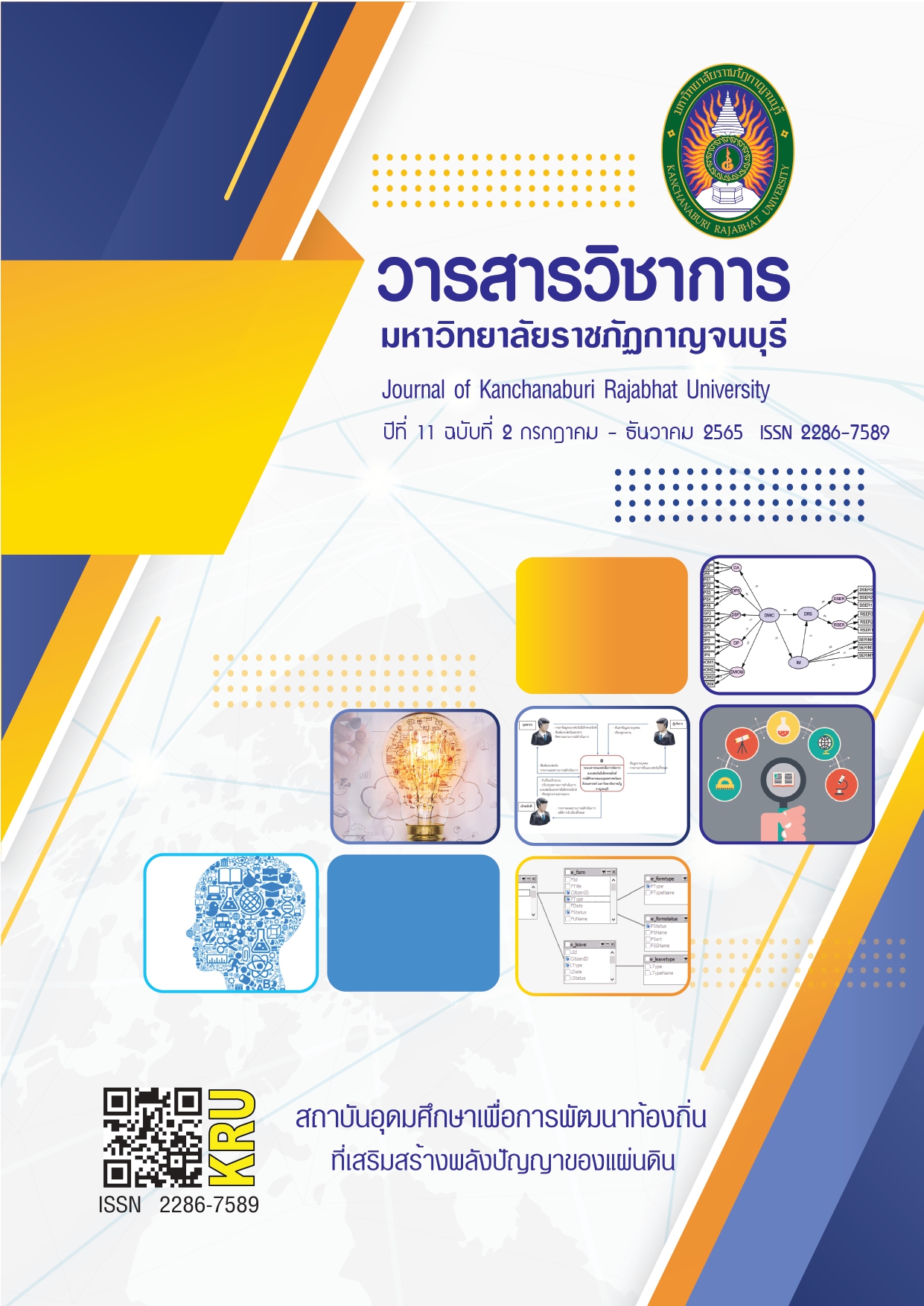THE DEVELOPMENT OF E-LEARNING WITH COOPERATIVE LEARNING USING THINK-PAIRS-SHARE TECHNIQUE ON BASIC MICRO:BIT FOR GRADE 6 STUDENTS OF BAN NONG PAK LONG SCHOOL
Main Article Content
Abstract
The aims of this research study were: 1) to develop and evaluate the quality of the content and production techniques of e-Learning with cooperative learning using Think-Pairs-Share technique on Basic Micro:bit for grade 6 students of Ban Nong Pak Long School, 2) to compare the students' pretest and posttest scores on e-Learning with cooperative learning using Think-Pairs-Share technique on Basic Micro:bit for grade 6 students of Ban Nong Pak Long School, and 3) to inquire students’ satisfaction towards e-Learning with cooperative learning using Think-Pairs-Share technique on Basic Micro:bit for grade 6 students of Ban Nong Pak Long School. The sample group, derived from purposive sampling, consisted of 38 students in Grade 6 of Ban Nong Pak Long School. The research instruments included an e-Learning course, an evaluation form for the quality of the content and production techniques, a learning achievement test, and a satisfaction questionnaire. The data were analyzed using Mean (), Standard Deviation (S.D.) and Compare Means.
The research findings were as follows: 1) The e-Learning course comprised three parts: 1.1) Getting to Know Micro:bit, 1.2) Micro:bit Control Programming, and 1.3) Creating Work with Micro:bit. The experts rated the quality of the e-Learning content at a very high level ( = 4.63, S.D.=0.41) and the quality of the e-Learning production techniques at a very high level (
= 4.69, S.D.=0.44); 2) The posttest score was higher than the pretest score; and 3) The students’ satisfaction towards e-Learning with cooperative learning using Think-Pairs-Share technique was at a very high level (
= 4.77, S.D.=0.46).
Article Details

This work is licensed under a Creative Commons Attribution-NonCommercial-NoDerivatives 4.0 International License.
References
กระทรวงดิจิทัลเพื่อเศรษฐกิจและสังคม. (2562). นโยบายและแผนระดับชาติว่าด้วยการพัฒนาดิจิทัลเพื่อเศรษฐกิจและสังคม (พ.ศ. 2561-2580).
ค้นเมื่อ เมษายน 7, 2563, จาก https://www.etda.or.th/content_files/2/files /05_Thailand_Digital_Plan.pdf.
จันทรา ตันติพงศานุรักษ์ และสุขเกษม ปิดตานะ. (2544). การจัดการเรียนรู้แบบร่วมมือ (พิมพ์ครั้งที่ 1). กรุงเทพฯ: ศูนย์พัฒนาหลักสูตร กรมวิชาการ.
ฐาปนีย์ ธรรมเมธา. (2557). อีเลิร์นนิง: จากทฤษฎีสู่การปฏิบัติ. กรุงเทพฯ: โครงการมหาวิทยาลัยไซเบอร์ไทยสำนักงานคณะกรรมการการอุดมศึกษา.
นพดล ผู้มีจรรยา และพรนภา อินทำ. (2563). การพัฒนาบทเรียนเอ็มเลิร์นนิงร่วมกับกระบวนการเรียนรู้แบบเพื่อนคู่คิด เรื่อง ไฟฟ้าน่ารู้ สำหรับชั้นประถมศึกษา
ปีที่ 4 โรงเรียนอนุบาลเทศบาลตำบลกรับใหญ่. วารสารสังคมศาสตร์วิจัย, 11(2), 75-89.
นวัฒธนโชติ อัครสำราญวงศ์ สัญชัย พัฒนสิทธิ์ และณัฐพล รำไพ. (2563). การพัฒนาบทเรียนออนไลน์ เรื่อง งานธุรกิจ สำหรับนักเรียนชั้นประถมศึกษาปีที่ 5
โรงเรียนลำบุหรี่พวง สำนักงานเขตหนองจอก สังกัดกรุงเทพมหานคร. ศึกษาศาสตร์สาร มหาวิทยาลัยเชียงใหม่, 4(3), 29-40.
บุญชม ศรีสะอาด. (2554). การวิจัยเบื้องต้น ฉบับพิมพ์ครั้งที่ 9 แก้ไขเพิ่มเติม. กรุงเทพฯ: สุวีริยาสาส์น.
ภานุมาศ กองพันธ์ และสวียา สุรมณี. (2560). การพัฒนาบทเรียนอีเลิร์นนิง เรื่อง หลักการทำโครงงานคอมพิวเตอร์ สำหรับชั้นมัธยมศึกษาปีที่ 3.
การประชุมวิชาการระดับชาติการจัดการเทคโนโลยีและนวัตกรรม ครั้งที่ 3 (หน้า 1-7). มหาสารคาม: มหาวิทยาลัยราชภัฏมหาสารคาม.
ศยามน อินสะอาด. (2561). การออกแบบบทเรียน e-Learning เพื่อพัฒนาทักษะการคิดขั้นสูง. กรุงเทพฯ: ซีเอ็ดยูเคชั่น.
สุพจน์ ศรีนุตพงษ์. (2562). CODING กิจกรรมการเรียนรู้เพื่อพัฒนาทักษะผู้เรียนในศตวรรษที่ 21. การสัมมนาเชิงปฏิบัติการทางนวัตกรรมและเทคโนโลยี
การศึกษา. นครปฐม: คณะศึกษาศาสตร์ มหาวิทยาลัยศิลปากร วิทยาเขตพระราชวังสนามจันทร์.
Adewale Owodunni Saka. (2020). Learning to Write Programs using Think-Pair-Share Programming Strategy: What are the Students'
Perceptions and Experiences? Journal of Educational Sciences, 4(4), 705-717.
Azlina, N. (2010). CETLs: Supporting Collaborative Activities Among Students and Teachers Through the Use of Think-Pair-Share
Techniques. International Journal of Computer Science Issues, 7(5), 18-29.
Choirul Abidin Siti Maghfirotun Amin and Raden Sulaiman. (2018). The Effect of Think-Pair-Share Learning with Contextual Approach on
Junior High School Students' Mathematics Problem Solving Ability. Advances in Intelligent Systems Research (AISR), 157, 31-34.
Kothiyal, A., Majumdar, R., Murthy, S., & Iyer, S. (2013). Effect of Think-Pair-Share in a Large CS1 Class: 83% Sustained Engagement.
Proceedings of the ninth annual international ACM conference on International computing education research (pp. 137-144).
New York: Association for Computing Machinery.
Kothiyal, A., Murthy, S., and Iyer, S. (2014). Think-pair-share in a large CS1 class: does learning really happen? Proceedings of the 2014
conference on Innovation & technology in computer science education (ITiCSE '14) (pp. 51–56). New York: Association for
Computing Machinery.
Rongbutsri, N., Yuan, F., Huang, J. J., Wang, W., and Zhang, F. (2018). E-Learning Providing Mobility in Learning Chinese as a Foreign
Language in Thailand. 2018 Global Wireless Summit (GWS), (pp. 55-58).
Schweitzer, D., Boleng, J., and Scharff, L. (2011). Interactive tools in the graphics classroom. Proceedings of the 16th annual joint
conference on Innovation and technology in computer science education (ITiCSE '11) (pp. 113–117). New York: Association for
Computing Machinery.
Zahedi, M. H., and Dehghan, Z. (2019). Effective E-learning utilizing Internet of Things. 2019 13th Iranian and 7th National Conference
on e-Learning and e-Teaching (ICeLeT), (pp. 1-6).


